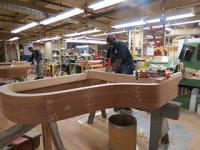Family-Owned Business
10 Ways Family-Owned Businesses Successfully Transition to the Next Generation of Ownership
The Challenge

Owner Louise Ciminieri, of Totonno’s Pizzeria Napolitana (Coney Island), does not want to talk about what will happen to her pizzeria, billed as the oldest, continually run, family-owned pizzeria in the U.S., when she retires, because so much is unknown. “It’s very hard to walk away from when it’s your blood and family.” she says.
We spoke to 100+ NYC Small Businesses. Read on for the result.
1. Make a Plan

Most of the family-owned businesses interviewed did not have a clear succession plan. Many had not identified a successor and even for those who had a clear successor, there usually was no timeline for when ownership would be transferred. Some owners discussed discomfort even thinking or talking about the next generation of their business. The next generation of owners expressed uncertainty and frustration with the lack of planning. They also worried about workers feeling uncertain about the businesses they work for.
In contrast, Adam Brand, of M & S Schmalberg (Garment District) is gradually, intentionally taking over the business, a fabric flower manufacturing studio, even though his father Warren isn’t retiring anytime soon. When his father takes a vacation, Adam runs the studio. Warren recently cut back to four days a week. “It’s happening slowly. He likes to control everything,” says Adam. He anticipates and accepts that Warren will continue to give input and visit the studio even when officially retired, like his grandfather did before him.
2. When no family is available, make a family

Owners frequently said creating a “family” environment is why their workers stay.
- Ernie Smith is the founder and owner of Penn & Fletcher (Long Island City), a custom embroidery shop, which has produced furniture for top designers and props for Law & Order sets. In his will, he has left the business to his workers, many of whom have been with him for decades. He says his family “wouldn’t know what to do with it.”
- David Gougelman, ocularist and owner of Mager & Gougelman Inc (Murray Hill), said the highly specialized trade of creating and fitting custom ocular prosthesis is passed on through 5-7 year apprenticeships. When family is not interested or available, the most common apprentices are patients who often already have a strong relationship and familiarity with the profession and owner.
3. Have an extended overlap between generations of ownership

- At Gillie’s Coffee (Sunset Park), a 174-year old business, the son of one of two owners focuses on spending time with Donald Schoenholt, his father’spartner, who is an expert and leader in the coffee sourcing industry in the U.S., rather than with his father who handles the financial side. “Anyone can learn the business side of running a business, but Donald has a depth of knowledge that no one else has, that would be lost.”
- At Q-Florist (Upper West Side), the 93-year-old owner still comes in once a week following a hip surgery to assist his son, as they navigate trying to find a niche for their small flower shop in the era of the Internet. “He helps tremendously because he knows everything about this business,” says his son.
- At Rosenwach Tank (Long Island City) succession has always been passed from father to son over four generations to “avoid family tension and drama.”Andrew Rosenwach, who is 60, learned the ropes from his father: “I tried to be his servant. I was his gofer for many years.”
Henry, 25, is the 5th generation to work at Rosenwach, and he’ll most likely take over the company one day. “I’m just still sort of going day by day. I never thought about it until I entered the business and realized how important a part of NYC it is. If we went out of business the city would go dry. It’s good to be confident and accept the role… As time keeps going on the more I invest myself in it. The more I find myself wanting to do it.”
4. Have the younger generation experience all roles in the business

- At Style Management (Hell’s Kitchen), a taxi company, second-generation owner Steve Rosenberg started by driving a cab.
- At Steinway and Sons (Astoria), the owners children and grandchildren started by sweeping the floors like most other workers begin.
- At Master Fire Prevention (East Tremont), owner Peter Rivera said he has been “rolling up his sleeves” since he began working for his father, arriving early, leaving late and doing work of all levels in the field and in the office.
5. Utilize the strengths of having multiple generations involved at once

- At Bridge Cleaners and Tailoring (Soho and Downtown Brooklyn), a high-end cleaning and tailoring business, the mother does qualitative and human relations work while the son focuses on financial growth and technology.
- At Green Kitchen (Upper East Side), Billy Karabatsos, 34, and his uncle 71, are co-owners. His uncle is a longtime restaurant owner who brought on their loyal staff and makes financial decisions, but leaves the daily operation of the business to his nephew.
- At Make My Cake (Harlem), owner Joann Baylor began her baking business in her kitchen, using her mother’s recipes from the baking traditions of the South and infused them with “Harlem Soul.” Her daughter Aliyyah Baylor has since become a partner in opening two retail shops, building a website, promoting their brand and moving into trends like shaped and air brush cakes and cakes for parties where parents reveal the gender of their babies.
6. Have clearly defined responsibilities and job descriptions
“We work with knives, but we don’t kill each other… We have our ups and downs. The bottom line is we’re family. We come in together, we go home together,” says Frank, one of three brothers who own Ottomanelli & Sons Meat Market (Greenwich Village), a 4th generation family-owned butcher shop. To run the shop efficiently, the brothers and Frank’s son, Matthew, divide responsibilities with one handling fresh hanging meats, another handling wholesale and so on.
7. Use older/experienced workers to train the next generation owner
At Little Wolf Cabinet Shop, owner John Wolf, Sr., a fourth generation cabinet maker from Germany, needed a way to teach his son, who grew up in the U.S., the craft. He asked one of his most skilled workers to spend his final year working before retirement passing on all of his knowledge.
“He told me he wanted to retire. I said, no, David, you’ve got one more year to go. Now you have to teach my son. He was a wonderful craftsman. All you have to do for the year is teach him. Now my son is a wonderful cabinet maker. And then he just had to learn to sell and design.”
8. Give the younger generation control before the older generation leaves
- At one Fort Greene store, a son left his corporate job and took over his father’s business when his father became ill with cancer. When his father healed, he wanted to continue his role controlling the business. This leaves his son managing the shop, but unable to make decisions – like how to treat staff or make changes to appeal to wealthier people moving into the neighborhood. “I went through the stages of anger until I accepted it. If the transfer goes through, I’d like to see it last for another two generations, but for now I just try to make the best of it.”
- At Little Wolf Cabinet Shop, the son has been there for 20 years. “I feel the struggle between my son and me but I’m relenting. I’m 76. My son is 46. I’m finished with the struggle,” says the father.
- Vivianne Tvilling has run her boutique Alskling for 20 years on the Upper West Side, working from 7 am to 9 pm, with help only from a few part-time workers. When she turned 65 this year, she decided she wanted more time to relax and try new things. She decided to travel for several months this winter and give a younger designer the opportunity to use her store as a pop up shop while she’s away. If this works, she’d like to follow this same model, giving a new, young designer the opportunity to try out running their own shop every year.
9. Recognize the value of long time employees in maintaining continuity, business relationships and history between owners
- At Dufour Pastry (Hunt’s Point), the plant staff turns over fairly regularly, but the office staff provides continuity. John, the sales manager, has been there for 26 years, almost the entire duration of company. He is passionate about the company, has strong relationships with the customers and enjoys traveling to meet with them. As the business is hiring a new National Sales Director, they are using John to help orient and train him.
- At Grand Prospect Hall (Park Slope), a 100+ year-old catering hall, longtime workers share stories of the “golden years” and important events held at the hall. They share the culture and institutional history for current workers, which adds a level of respect and care to everyone’s work.
- Anthony Grando has worked at International Asbestos Removal (Flushing) for two generations. The current owner Karen Grando (no relation), says Anthony has been the “steady hand” and “consistent force” between management changes. In his 70s, he gradually reduced his work days from 5 to 4 to 3 before stepping down. He is now in his 80s, and through recently retired, still comes to the business’s weekly staff meeting and provides valuable input.
10. Cross train workers so everyone understands the business
Steve Giumenta, owner of Architectural Grille (Gowanus), a company started by his grandfather, says, “The model of creating a situation where someone is irreplaceable doesn’t work for a small business.”
“We try to cross train employees so that everyone has a sense of the jobs that people are doing so that in the event something abruptly happens and someone leaves, they are able and prepared for things to keep moving. This is helpful even when someone goes on vacation.”
During Hurricane Sandy, their shop was ravaged and they had to lay off 50 workers. He credits having the remaining workers understand the work of the positions that were lost as the only way they survived and are now growing.
“Thankfully people were cross trained enough in advance that they could jump in and help get things up and going. You aren’t left holding the bag and neither is the customer.”
